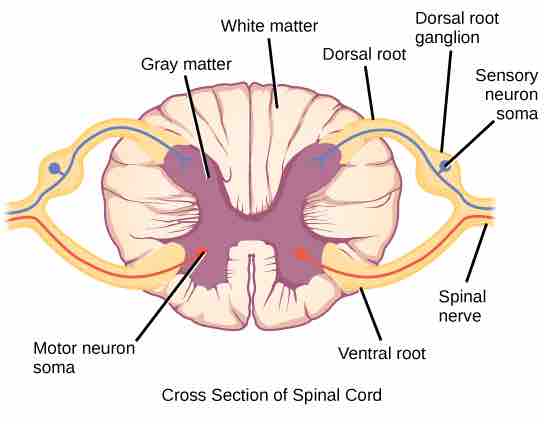Sensory-Somatic Nervous System
The sensory-somatic nervous system is composed of cranial and spinal nerves and contains both sensory and motor neurons. Sensory neurons transmit sensory information from the skin, skeletal muscle, and sensory organs to the central nervous system (CNS). Motor neurons transmit messages about desired movement from the CNS to the muscles, causing them to contract. Without its sensory-somatic nervous system, an animal would be unable to process any information about its environment (what it sees, feels, hears, etc. ) and could not control motor movements. Unlike the autonomic nervous system, which has two synapses between the CNS and the target organ, sensory and motor neurons have only one synapse: one ending of the neuron is at the organ and the other directly contacts a CNS neuron. Acetylcholine is the main neurotransmitter released at these synapses.
Cranial Nerves
Humans have 12 cranial nerves, nerves that emerge from or enter the skull (cranium), as opposed to the spinal nerves, which emerge from the vertebral column. Each cranial nerve has a name . Some cranial nerves transmit only sensory information. For example, the olfactory nerve transmits information about smells from the nose to the brainstem. Other cranial nerves transmit almost solely motor information. The oculomotor nerve controls the opening and closing of the eyelid and some eye movements. Other cranial nerves contain a mix of sensory and motor fibers. For example, the glossopharyngeal nerve has a role in both taste (sensory) and swallowing (motor).

Cranial nerves
The human brain contains 12 cranial nerves that receive sensory input and control motor output for the head and neck.
Spinal Nerves
Spinal nerves transmit sensory and motor information between the spinal cord and the rest of the body. Each of the 31 spinal nerves (in humans) contains both sensory and motor axons. The sensory neuron cell bodies are grouped in structures called dorsal root ganglia . Each sensory neuron has one projection with a sensory receptor ending in skin, muscle, or sensory organs, and another that synapses with a neuron in the dorsal spinal cord. Motor neurons have cell bodies in the ventral gray matter of the spinal cord that project to muscle through the ventral root. These neurons are usually stimulated by interneurons within the spinal cord, but are sometimes directly stimulated by sensory neurons.

Spinal nerves
Spinal nerves contain both sensory and motor axons. The cell bodies of sensory neurons are located in dorsal root ganglia. The cell bodies of motor neurons are found in the ventral portion of the gray matter of the spinal cord.